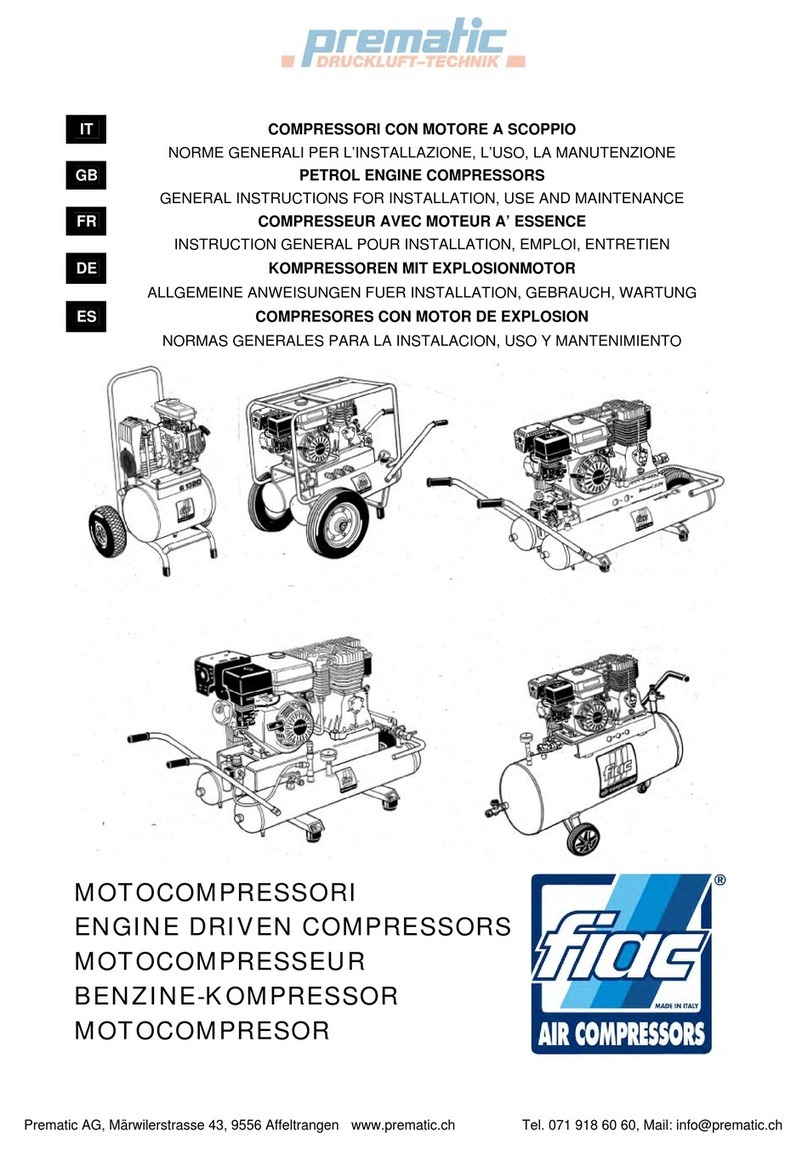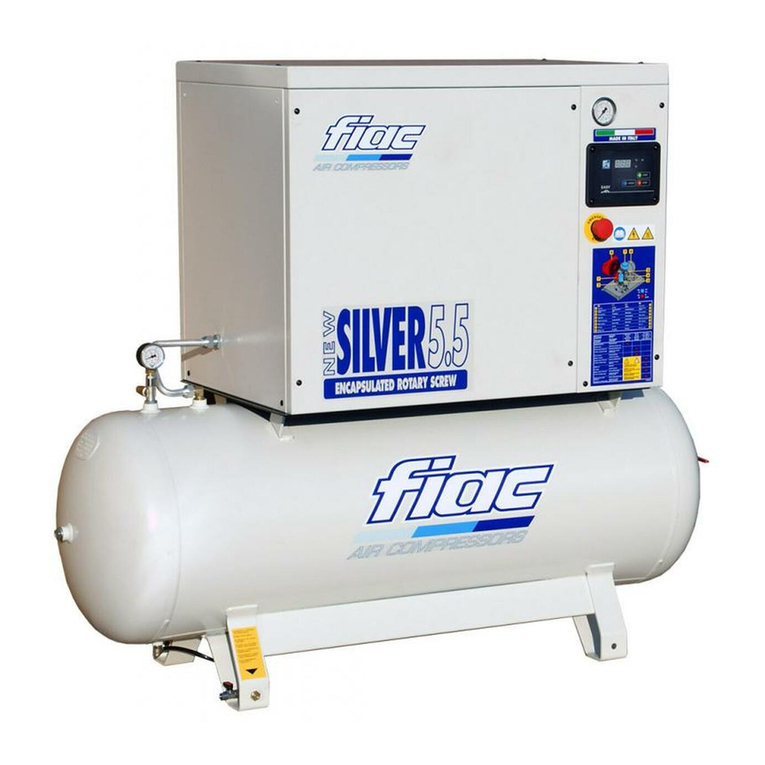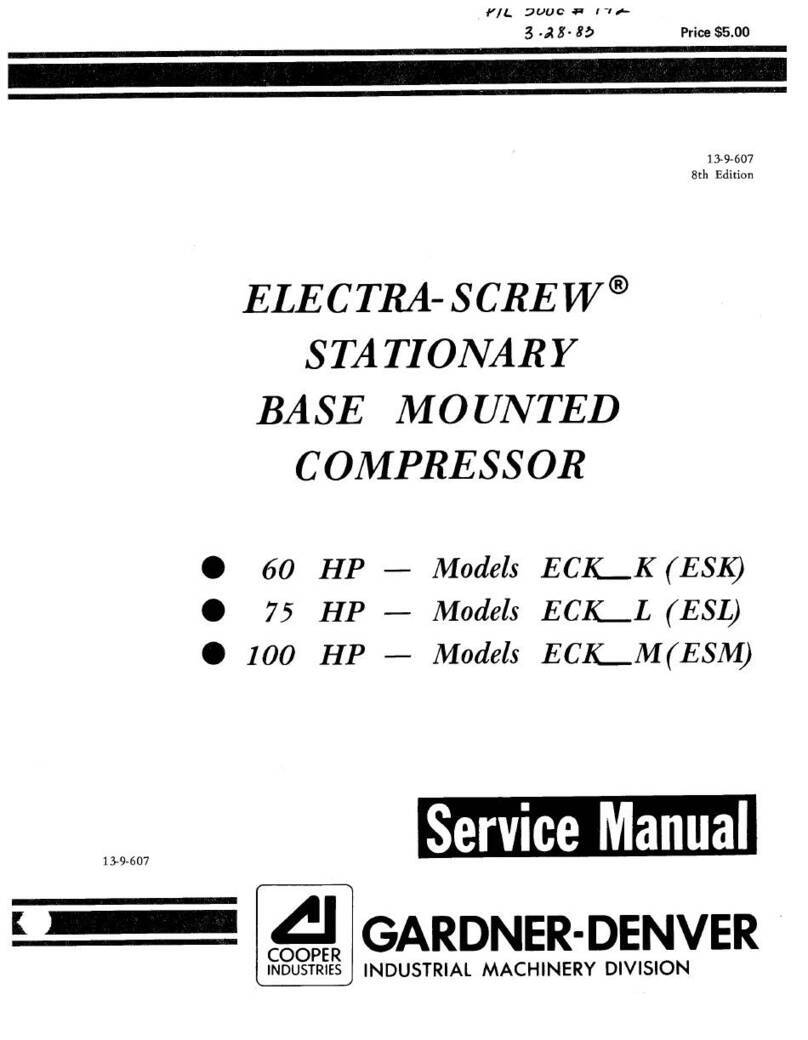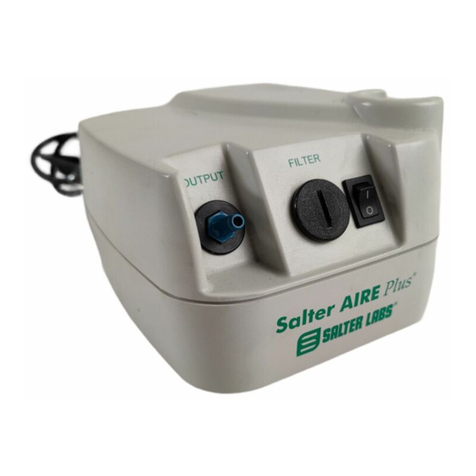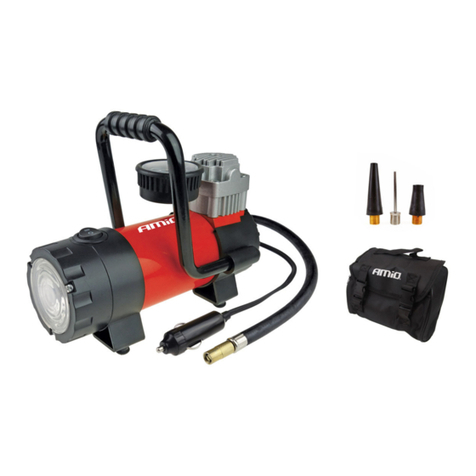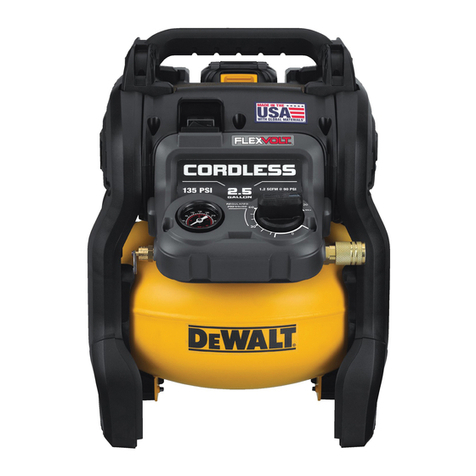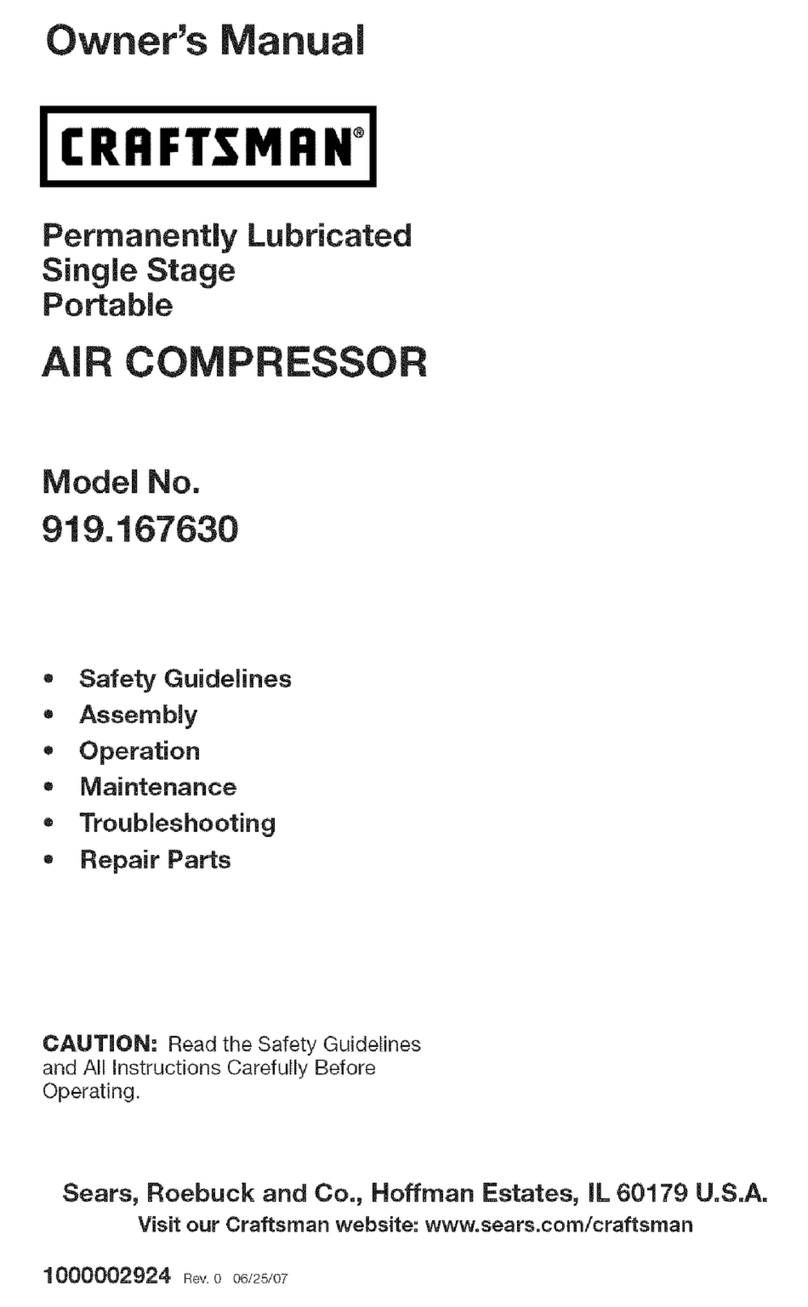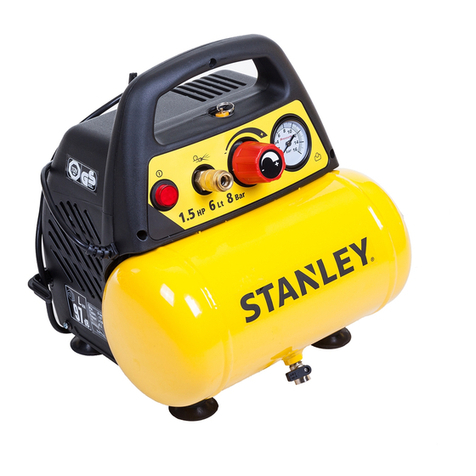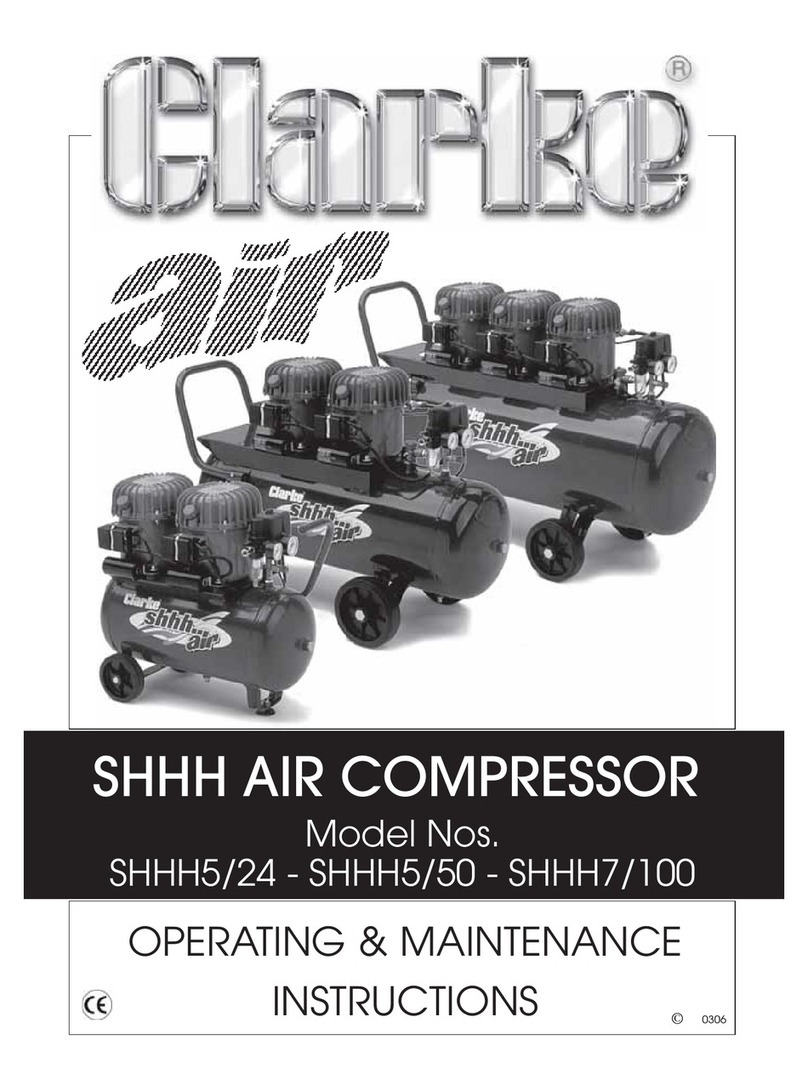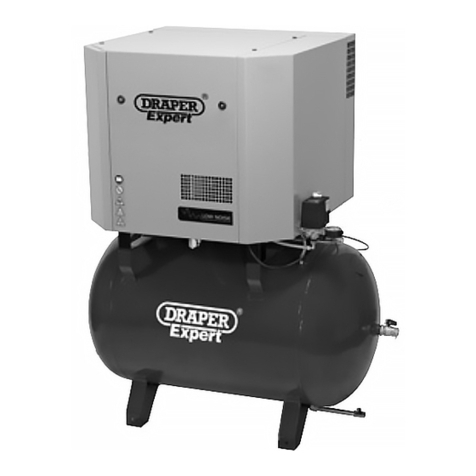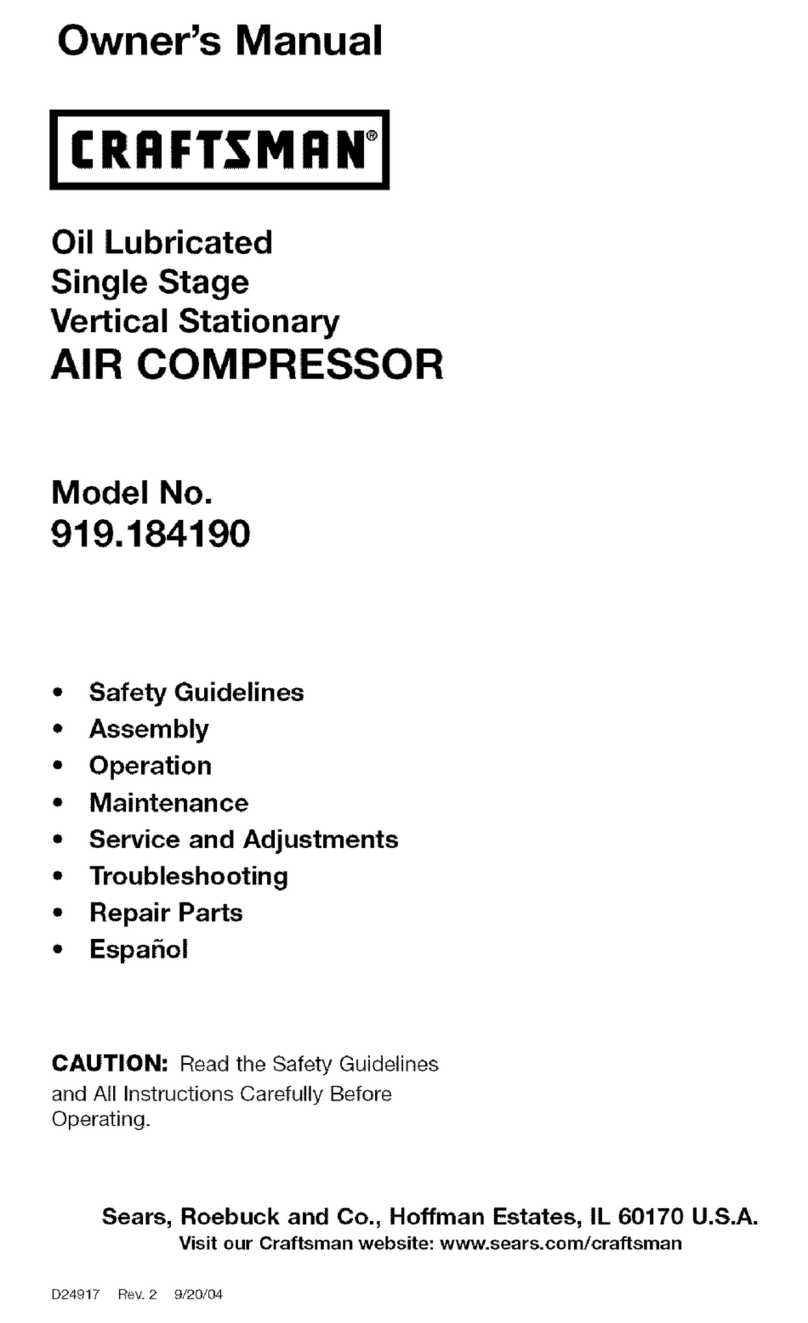fiac AIRBLOK 40 User manual

1/68
GB
USE AND MAINTENANCE MANUAL
SILENT ELECTRIC ROTARY SCREW COMPRESSORS
WARNING: Read this manual carefully and in full before using the compressor.

2/68
IMPORTANT INFORMATION
Read all the operational instructions, safety recommendations and all warnings provided in the instruction manual.
Most accidents encountered when using the compressor are merely due to the failed observance of basic safety
standards.
Accidents are prevented by foreseeing potentially hazardous situations and observing the appropriate safety
standards.
The fundamental safety standards are listed in the “SAFETY” section of this manual and also in the section involving
the use and maintenance of the compressor.
Hazardous situations to be avoided in order to prevent serious personal injuries and machine damages are listed in
the “WARNINGS” section of the instruction manual or are actually printed on the machine.
Never use the compressor improperly but only as recommended by the Manufacturer.
The Manufacturer reserves the right to up-date the technical information given in this manual without notice.

3/68
GB
INDEX I
I Index
0 Foreword ......................................................................................... 5
0.1 How to read and use the instruction manual ............................................. 5
0.1.a Importance of the manual .................................................................................................... 5
0.1.b Conserving the manual ........................................................................................................ 5
0.1.c Consulting the manual ......................................................................................................... 5
0.1.d Symbols used ........................................................................................................................ 6
1 General information........................................................................ 7
1.1 Identification data of the manufacturer and the compressor ................... 7
1.2 Information on machine technical/maintenance service .......................... 7
1.3 General safety warnings .............................................................................. 7
2 Preliminary machine information ................................................ 10
2.1 General description .................................................................................... 10
2.2 Intended use ................................................................................................ 10
2.3 Technical data ............................................................................................. 11
3 Transport, Handling, Storage ...................................................... 12
3.1 Transporting and handling the packed machine ..................................... 12
3.2 Packing and unpacking .............................................................................. 12
3.3 Storing the packed and unpacked compressor ....................................... 13
4 Installation ..................................................................................... 14
4.1 Admitted surrounding conditions ............................................................. 14
4.2 Space required for maintenance ............................................................... 14
4.3 Positioning the compressor ...................................................................... 15
4.4
Connecting the compressor to the sources of energy and relative inspections
16
4.4.1 Connecting the compressor to the electrical mains power supply ................................ 16
4.4.2 Connecting the dryer to the electrical mains ................................................................... 18
5 Using the compressor .................................................................. 19
5.1 Preparing to use the compressor .............................................................. 19
5.1.1 Operational principle .......................................................................................................... 19
5.1.2 Compressor operation with inverter versions “SD” (speed driven) .............................. 19
5.2 Controls, indicators and safety devices of the compressor ................... 20
5.2.1 Control panel ....................................................................................................................... 20
5.2.2 Auxiliary control devices .................................................................................................... 21
5.2.3 Description of the Electronic Control Unit ....................................................................... 21
5.3 Check the efficiency of the safety devices before starting ..................... 30

4/68
GB I INDEX
5.4 Starting the compressor............................................................................. 29
5.5 Stopping the compressor .......................................................................... 30
6 Compressor maintenance............................................................ 31
6.1 Instructions relative to inspections and maintenance jobs. ................... 31
6.1.1 Changing the oil .................................................................................................................. 33
6.1.2 Replacing the oil filter cartridge ........................................................................................ 34
6.1.3 Replacing the filter cartridge of the oil separator ............................................................ 34
6.1.4 Replacing the air filter cartridge ........................................................................................ 35
6.1.5 .............................................................................................................................................. 35
6.1.6 Cleaning the air/oil radiator ................................................................................................ 36
6.7.7 Cleaning the dust-removal pre-filter ................................................................................. 36
6.1.8 Grease the bearings of the motor...................................................................................... 36
6.1.9 .............................................................................................................................................. 37
6.1.10 .............................................................................................................................................. 37
6.1.11 .............................................................................................................................................. 38
6.2 Diagnosing the alarm status/inconveniences-faults ............................... 38
7 Drawings and diagrams ............................................................... 41
7.1 Wiring diagrams .......................................................................................... 41
7.2 Pneumatic diagrams ................................................................................... 46
7.3 Maintenance schedule

5/68
FOREWORD 0 GB
0 Foreword
0.1 How to read and use the instruction manual
0.1.a Importance of the manual
This INSTRUCTION MANUAL has been written to guide you through the INSTALLATION, USE and
MAINTENANCE of the compressor purchased.
We recommend that you strictly observe all the indications given within as the ideal operational efficiency
and lasting wear of the compressor depend on the correct use and methodical application of the
maintenance instructions given hereafter.
Remember that when any doubts or inconveniences arise it is a good rule to always contact the
AUTHORISED SERVICE CENTRES. They are at your complete disposal for any explanations or jobs
required.
The Manufacturer therefore declines all liabilities regarding the incorrect use and poor maintenance of the
compressor.
The INSTRUCTION MANUAL is integral part of the compressor.
Ensure that any up-dates forwarded by the Manufacturer are actually added to the manual.
If the compressor is sold on at a later date the manual must be given to the new owner.
0.1.b Conserving the manual
Use and read the manual with care being careful not to damage any part of it.
Do not remove, tear or re-write any parts of the manual for any reason whatsoever.
Keep the manual in a dry and sheltered place.
0.1.c Consulting the manual
This instruction manual is made up of the following:
• FRONT COVER WITH MACHINE IDENTIFICATION
• DETAILED INDEX
• INSTRUCTIONS AND/OR NOTES ON THE COMPRESSOR
The model and serial number of the compressor to which the manual refers and that you have purchased
is found on the FRONT COVER.
The various SECTIONS in which all the notes relative to a certain subject are found in the INDEX.
All theINSTRUCTIONS AND/OR NOTES ON THE COMPRESSOR aim at pointing out safety warnings and
procedures required to use the compressor correctly.

6/68
GB 0 FOREWORD
0.1.d Symbols used
The SYMBOLS pointed out below are used throughout this manual and their purpose is that of drawing the
operator’s attention, informing the latter how to behave and how to proceed in each operational situation.
READ THE INSTRUCTION MANUAL
Read the use and maintenance manual carefully before installing and starting the
compressor.
GENERAL HAZARDOUS SITUATION
An additional note will point out the type of hazard involved.
Meaning of the indications:
Warning! This points out a potentially hazardous situation, which if ignored, could cause personal
injury and machine damage.
Note! This enhances crucial information.
RISK OF ELECTRIC SHOCK
Warning: the electrical power supply of the compressor must be disconnected before doing
any jobs on the compressor.
RISK OF SCOLDING
Warning: be careful when touching the compressor as some parts of it could be very hot.

7/68
GB
GENERAL INFORMATION 1
1 General information
1.1 Identification data of the manufacturer and the compressor
COMPRESSOR
IDENTIFICATION
NAMEPLATE (Example)
Silent electric rotary screw
compressor.
1.2 Information on machine technical/maintenance service
We remind you that our technical service department is at your complete disposal to help you resolve any
problems that may possibly be encountered, or to provide you with any other information necessary.
In the case of need contact:
Our CUSTOMER TECHNICAL SERVICE department or your local dealer.
The constant and efficient performance of the compressor is ensured only if original spare parts are used.
We recommend therefore that you strictly observe the indications provided in the MAINTENANCE section
and to use EXCLUSIVELY original spare parts.
The use of NON ORIGINAL spare parts automatically annuls the guarantee.
1.3 General safety warnings
Note! The procedures provided in this manual have been written to assist the operator
throughout the use and maintenance of the compressor.
IMPORTANT INSTRUCTIONS FOR THE SAFE USE OF THE COMPRESSOR
WARNING: THE INAPPROPRIATE USE AND POOR MAINTENANCE OF THIS COMPRESSOR MAY
CAUSE PHYSICAL INJURY TO THE USER. YOU ARE RECOMMENDED TO CAREFULLY FOLLOW
THE INSTRUCTIONS PROVIDED HEREAFTER TO AVOID SUCH RISKS.
1. DO NOT TOUCH MOVING PARTS
Never put your hands, fingers or other parts of the body near moving parts of the compressor.

8/68
GB 1 GENERAL INFORMATION
2. NEVER USE THE COMPRESSOR WITHOUT THE SAFETY GUARDS FITTED
Never use the compressor without all the safety guards fitted perfectly in their correct place (i.e. panelling,
belt guard, safety valve). If these parts are to be removed for maintenance or servicing purposes, ensure
that they are put back in their original place perfectly before using the compressor again.
3. ALWAYS WEAR SAFETY GOGGLES
Always wear goggles or equivalent eye protection means. Never direct compressed air towards any part of
your body or that of others.
4. PROTECT YOURSELF AGAINST ELECTRIC SHOCKS
Avoid accidentally touching the metal parts of the compressor with your body, such as pipes, the tank or
metal parts connected to earth. Never use the compressor where there is water or in damp rooms.
For SD versions: Switch the electric control panel off and wait five minutes before removing the protection
guards of the inverter to avoid possible electrical shocks. Using special testers, always ensure there is no
voltage on the parts on which you are about to work.
5. DISCONNECT THE COMPRESSOR
Disconnect the compressor from the electric power supply and completely discharge the pressure from the
tank before carrying out any service, inspection, maintenance, cleaning, replacing or inspection jobs of each
part.
6. ACCIDENTAL START-UP
Never move the compressor while it is connected to the electrical power supply or when the tank is
pressurised. Ensure that the main switch is turned OFF before connecting the compressor to the electrical
power supply.
7. STORE THE COMPRESSOR APPROPRIATELY
When the compressor is not in use, it must be stored in a dry room away from atmospheric agents. Keep
it out of children’s reach.
8. OPERATIONAL AREA
Keep the work area clean and remove any tools that are not required. Keep the work area sufficiently
ventilated. Never use the compressor in the presence of flammable liquids or gas. The compressor may
produce sparks while running. Do not use the compressor where there may be paints, gasoline, chemical
compounds, glues and any other flammable or explosive material.
9. KEEP THE COMPRESSOR OUT OF CHILDREN’S REACH
Prevent children or anyone else from touching the power supply cable of the compressor. All outsiders must
be kept at a safe distance from the operational area.
10.WORK CLOTHES
Do not wear unsuitable clothing, ties or jewellery as these may get caught up in moving parts. Wear caps
to cover your hair if necessary.
11.PRECAUTIONS FOR THE POWER SUPPLY CABLE
Do not disconnect the power supply plug by pulling on the cable. Keep the cable away from heat, oil and sharp
edges. Do not stand on the electrical cable or squash it under heavy weights.
12.LOOK AFTER THE COMPRESSOR WITH CARE
Follow the maintenance instructions. Inspect the power supply cable on a periodic basis and if damaged it
must be repaired or replaced by an authorised service centre. Visually check the outside appearance of the
compressor, ensuring that there are no visual anomalies. Contact your nearest service centre if necessary.
13.ELECTRICAL EXTENSIONS FOR OUTDOOR USE
When the compressor is used outdoors, use only electrical extensions manufactured for outdoor use and
marked as such.
14.WARNING
Pay attention to everything you do. Use your common sense.
Do not use the compressor if you are tired. The compressor must never be used if you are under the effect
of alcohol, drugs or medicines, which could make you tired.
15.CHECK FAULTY PARTS OR AIR LEAKS
Before using the compressor again, if a safety guard or other parts are damaged, they must be checked
carefully to evaluate whether they may operate as established in complete safety.
Check the alignment of moving parts, hoses, gauges, pressure reducers, pneumatic connections and every
other part that may be crucial for the normal operational efficiency of the compressor. All damaged parts
must be properly repaired or replaced by an authorised service centre or replaced following the instructions
provided in instruction manual.
16.USE THE COMPRESSOR EXCLUSIVELY FOR THE APPLICATIONS SPECIFIED IN THIS
INSTRUCTION MANUAL.
The compressor is a machine that produces compressed air.
Never use the compressor for purposes other than those specified in the instruction manual.
17.USE THE COMPRESSOR CORRECTLY
Operate the compressor in compliance with the instructions provided in this manual. Do not allow children
to use the compressor or those who are not familiar with it.

9/68
GB
GENERAL INFORMATION 1
18.ENSURE THAT EACH SCREW, BOLT AND GUARD IS FIRMLY SECURED IN PLACE.
19.KEEP THE IN-TAKE GRIDS CLEAN
Keep the motor ventilation grids clean. Regularly clean these grids if the work area is particularly dirty.
20.OPERATE THE COMPRESSOR AT THE RATED VOLTAGE
Operate the compressor at the voltage specified on the electrical data nameplate. If the compressor is used
at a higher voltage than that rated, the motor could damage or burn out.
21.NEVER USE THE COMPRESSOR IF IT IS FAULTY
If the compressor is noisy or vibrates excessively when running or it seems to be faulty, stop it immediately
and check its efficiency or contact your nearest authorised service centre.
22.DO NOT CLEAN PLASTIC PARTS USING SOLVENTS
Solvents such as gasoline, thinners, gas oil or other compounds that contain hydrocarbons may damage
the plastic parts. Clean them with a soft cloth and soapy water or other suitable liquids.
23.USE ORGINAL SPARE PARTS ONLY
The use of non-original spare parts involves the annulment of the guarantee and the abnormal running
conditions of the compressor. Original spare parts are available c/o the authorised dealers.
24.DO NOT MODIFY THE COMPRESSOR
Do not modify the compressor. Contact an authorised service centre for all repairs required. An unauthorised
modification may impair the efficiency of the compressor and may also cause serious accidents for those
who do not have the technical skill required to make such modifications.
25.TURN THE COMPRESSOR OFF WHEN IT IS NOT IN USE
When the compressor is not in use turn the main ON/OFF switch OFF (position “0”).
26.DO NOT TOUCH HOT PARTS OF THE COMPRESSOR
To avoid scolding do not touch pipes, the motor or any other hot part.
27.DO NOT DIRECT THE JET OF AIR DIRECTLY TOWARDS THE BODY
To avoid all risks never direct the jet of air towards people or animals.
28.DO NOT STOP THE COMPRESSOR BY PULLING ON THE POWER SUPPLY CABLE
Use the “O/I” (ON/OFF) switch to stop the compressor.
29.PNEUMATIC CIRCUIT
Use recommended pneumatic hoses and tools that can withstand the same or a higher pressure than the
maximum running pressure of the compressor.
30.SPARE PARTS
Use only original and identical spare parts to replace worn or damaged ones.
Repairs must be made exclusively by authorised service centres.
31.CORRECT USE OF THE COMPRESSOR
The operator must be perfectly familiar with all the controls and compressor characteristics before starting
to work with the machine.
32.MAINTENANCE JOBS
The use and maintenance jobs of the commercial components fitted on the machine, but not indicated in
this manual, are indicated in the enclosed documents.
33.DO NOT UNSCREW THE CONNECTION WHEN THE TANK IS PRESSURISED
Do not unscrew the connection for any reason whatsoever with the tank pressurised without first checking
if the tank is discharged.
34.DO NOT MODIFY THE TANK
It is prohibited to intentionally drill, weld or deform the compressed air tank.
35.IF THE COMPRESSOR IS USED FOR PAINTING JOBS
a) Do not work in closed rooms or near free flames.
b) Ensure that the room in which you are working is sufficiently ventilated.
c) Wear face and nose mask.
36.DO NOT PUT OBJECTS OR HANDS INSIDE THE PROTECTION GRID
Do not put objects or hands inside the protection grid to avoid physical and material damages.
KEEP THESE USE AND MAINTENANCE INSTRUCTIONS CAREFULLY AND GIVE
THEM TO PERSONNEL WISHING TO USE THE COMPRESSOR!
WE RESERVE THE RIGHT TO MAKE MODIFICATIONS WHERE NECESSARY
WITHOUT NOTICE

10/68
GB 2 PRELIMINARY MACHINE INFORMATION
2 Preliminary machine information
2.1 General description
The rotary screw compressor has been specifically designed aiming at minimising maintenance and labour costs.
The outside cabinet is completely covered in sound-proof and oil-proof panelling thus ensuring its extended and lasting wear.
The components have been arranged so that all vital parts can be easily reached for maintenance purposes
simply by opening dedicated panels with quick-release locking devices.
The filters and adjustment and safety devices (oil filter, air filter, oil separator filter, regulator valve, minimum
pressure valve, max. pressure safety valve, thermostat, belt tightener, screw compression unit, pressure
switch and oil separator tank emptying and filling taps) are all fitted on the same side.
Note! The tanks of the compressors have been manufactured in compliance with the EEC/
404/87 Directive for the European market. The compressors have been manufactured
in compliance with the EC/37/98 Directive for the European market.
Note! Check your model on the identification nameplate fitted on the compressor. It is also
indicated in this manual.
ADVISED LUBRICANTS
Always use oil for turbines with approximately 46 cSt at 40°C and a pour point of at least -8 +10°C. The
flash point must be greater than +200°C.
The oil in rotary screw compressors has the function of lubricating and cooling the screw unit. The oil also
has a sealing function to ensure a perfect compression seal within the block.
Therefore it is extremely important to choose the correct type of oil for this type of compressor.
NEVER MIX DIFFERENT OIL QUALITIES.
SCREW OIL FOR DR/SD VERSIONS
FIAC SYNT/RS D 46
OR IN ALTERNATIVE
SHELL CORENA AS46
MOBIL RARUS SHC 1025
OR 100% SYNTHETIC OIL WITH THE SAME TECHNICAL CHARACTERISTICS AS THOSE LISTED
ABOVE
Use oil with VG32 rating for cold climates and VG68 for tropical climates.
It is advisable to use synthetic oils for very hot and humid climates.
2.2 Intended use
The silent rotary screw compressors have been designed and manufactured exclusively to produce compressed air.
EVERY OTHER USE, DIFFERENT AND NOT FORESEEN BY ALL INDICATED, RELIEVES THE
MANUFACTURER OF POSSIBLE CONSEQUENT RISKS.
In any event the use of the compressor different to that agreed in the purchase order RELIEVES THE
MANUFACTURER FROM ALL LIABILITIES WITH REGARD TO POSSIBLE MATERIAL DAMAGE AND
PERSONAL INJURY.
The electrical system is not designed for the use in environments subject to explosion or for flammable products.
NEVER DIRECT THE JET OF AIR TOWARDS PEOPLE OR ANIMALS. NEVER USE
THE COMPRESSED AIR PRODUCED BY LUBRICATED COMPRESSORS FOR
RESPIRATORY PURPOSES OR IN PRODUCTION PROCESSES WHERE THE AIR IS
IN DIRECT CONTACT WITH FOODSTUFFS UNLESS IT HAS BEEN FIRST FILTERED
AND CONDITIONED FOR SUCH PURPOSE.

11/68
GB
PRELIMINARY MACHINE INFORMATION 2
HP40 HP50
bar/psi 8-116 10-145 13-188 8-116 10-145 13-188
l/min 1260÷4840 1210÷4280 1160÷3750 2050÷5850 1900÷5270 1750÷4500
cfm 44÷171 43÷151 41÷132 72÷207 67÷186 62÷159
R1” ½ G 1” ½ G 1” ½ G 1” ½ G 1” ½ G 1” ½ G
l51 51 51 51 51 51
m3/h
ppm ≤1≤1≤1≤1≤1≤1
IEC
HP/kW 40/30 40/30 40/30 50/37 50/37 50/37
IP 55 55 55 55 55 55
S1S1S1 S1S1S1
N°
°C (min/max) 5/45 5/45 5/45 5/45 5/45 5/45
dB(A) 67 67 67 69 69 69
1750 X 950 X 1700 1750 X 950 X1700
980 1000
2.3 Technical data
Model
Max. pressure
Free air delivery ISO 1217
Air outlet fitting
Lubricant qty
Fan capacity
Oil residue in air
2-pole electric motor
Output
Protection rating
Service
Max. starts per hour
Ambient temperature limits
Noise level (2000/14/CE)
Dimensions mm
Weight Kg
Sound level measured in a free range at a distance of 1 m: ±3dB(A) at the maximum working pressure.
The sound level may increase by 1 to 10 dB(A) depending on the room in which the compressor is installed.
Note! The technical data and dimensions of the machine are subject to variations at any time without notice

12/68
GB 2 PRELIMINARY MACHINE INFORMATION
3 Transport, Handling, Storage
In order to use the compressor in complete safety read the safety standards given
in section 1.3. before reading this section.
3.1 Transporting and handling the packed machine
The packed compressor must be transported by qualified personnel using a forklift
truck.
Before moving the machine ensure that the load-bearing capacity of the forklift truck is sufficient to take the
weight to be lifted.
Position the forks exclusively as illustrated below. Once the forks have been positioned in the points
indicated, lift slowly without jerking.
Never stand near the area where the compressor is being handled and never stand
on the crate while it is being moved.
3.2 Packing and unpacking
To avoid damages and to protect the compressor during transport it is usually placed on a wooden pallet,
to which it is secured by screws and covered with cardboard.
All the shipping and handling information and symbols are printed on the compressor packing. Upon
consignment remove the top part of the packing and check if any damages have been encountered during
transport. If any damages are found, caused during transport, immediately make a written claim, backed
up with photos of the damaged parts if possible and forward everything to your insurance company, with copy
to the Manufacturer and transporter.

13/68
GB
PRELIMINARY MACHINE INFORMATION 2
1
2
Using a forklift truck take the compressor as near as possible to the place where it is to be installed then
carefully remove the protective packing without damaging it, following the instructions below:
• Remove the securing screws and open cage 1.
• Take the protective cardboard 2off.
Note! The compressor can be left on the packing pallet to make it easier to move.
Carefully ensure that the contents correspond with all written in the consignment documents. Dispose of
the packing in compliance with current standards in force in the country of installation.
Note! The machine must be unpacked by qualified personnel using appropriate tools and
equipment.
3.3 Storing the packed and unpacked compressor
For the whole time that the compressor is not used before unpacking it, store it in a dry place at a temperature
between +5°C and + 45°C and sheltered away from weather.
For the whole time that the compressor is not used after unpacking it, while waiting to start it up or due to
production stoppages, place sheets over it to protect it from dust, which may settle on the components.
The oil is to be replaced and the operational efficiency of the compressor is to be checked if it is not used
for long periods.

14/68
GB 4 INSTALLATION
4 Installation
In order to use the compressor in complete safety read the safety standards given
in section 1.3. before reading this section.
4.1 Admitted surrounding conditions
Position the machine as established when the order was placed. Failing this the Manufacturer is not liable
for any inconveniences that may possibly arise.
For SD versions, the cleanliness of the surrounding area is of extreme importance, as the
compressor is equipped with suction filters on the electric fan of the electric control panel.
Unless pointed out otherwise when placing the order, the compressor must work regularly in the
surrounding conditions indicated below:
ROOM TEMPERATURE
The room temperature must not be lower than 5°C or higher than 45°C to ensure the ideal operational
efficiency of the compressor.
If the compressor works at a room temperature lower than the minimum value, the condensate could be
separated within the circuit and therefore the water would mix with the oil, thus deteriorating the quality of
the latter, failing to guarantee the even formation of the lubricating film between the moving parts with the
possibility of seizure.
If the compressor works at a room temperature higher than maximum value, the compressor would take
in air that is too hot, which would prevent the heat exchanger from adequately cooling the oil in the circuit,
raising the working temperature of the machine, thus causing the thermal safety device to trip, which stops
the compressor due to an excessive temperature of the air/oil mixture at the screw outlet.
The inverter dissipator could overheat, causing it to stop (for SD versions).
The maximum temperature of the room is to be measured while the compressor is running.
LIGHTING
The compressor has been designed in compliance with legal prescriptions and in the attempt to minimise
shadow zones to facilitate the operator’s job.
The lighting system of the factory is to be considered as crucial for the operator’s safety.
The room in which the compressor is installed must have no shadow zones, dazzling lights or stroboscopic
effects due to the lighting.
ATMOSPHERE WITH RISK OF EXPLOSION AND/OR FIRE
The standard compressor is not pre-arranged or designed to work in rooms subject to the risk of explosion
or fire. The performance of the compressor may decrease at the maximum permitted ambient temperature,
with relative humidity higher than 80% and at an altitude of more than 1,000 mt.
For SD versions, the maximum relative humidity at all altitudes is 95% without condensation.
4.2 Space required for maintenance
The compressor must be installed in a large room that is well-aired, dust-free and sheltered away from rain
and frost. The compressor takes in a large amount of air that is required to ventilate it internally. A dusty
atmosphere would in time cause damages and inefficient performance.
Part of the dust once inside is taken in by the air filter causing it to clog rapidly and another part of dust will
settle on the components and will be blown against the cooling radiator, consequently compromising the
efficiency of the heat exchanger. It is therefore obvious that the cleanliness of the area in which the
compressor is installed is crucial for the correct efficiency of the machine, avoiding excessive running and
maintenance costs. To facilitate maintenance jobs and to create a favourable circulation of air, the
compressor must have a sufficient free space all around it (see fig.).
The room must be provided with outlets that lead outdoors near the floor and ceiling that will allow the natural
circulation of air. If this is impossible, some fans or extractors must be fitted to ensure an air flow rate 20%
higher than the cooling air flow rate. Minimum recommended fan capacity: 2500 m3/h.

15/68
GB
INSTALLATION 4
2000
H. min = 3500
min. 5000
min. 1000
200
min. 3200
1
Ducts for the inlet and outlet of the air can be used in unfavourable environments. These ducts must be the
same size as the in-take and delivery grid. If these ducts are longer than 3 meters contact the Authorised
Service Centre.
Note! A conveyance system can be fitted to recover the hot ventilation air delivered, which
can be used to heat the room or for other purposes. It is crucial that the cross section
of the system that recovers the hot air is greater than the total cross section of the
grid slots plus the system must be equipped with a forced extraction system
(extractor fan 1) to favour a constant downflow. (minimum cross section 1200 cm²).
4.3 Positioning the compressor
Once the position in which the compressor is to be installed has been identified ensure that the compressor
is set on a flat surface.
No special foundations or bases are required for the machine.
Do not secure the compressor rigidly to the floor.

16/68
GB 4 INSTALLATION
1
4.4 Connecting the compressor to the sources of energy and relative inspections.
4.4.1 Connecting the compressor to the electrical mains power supply
The compressor is to be connected to the electrical mains by the customer, to his
exclusive liability, employing specialised personnel and in compliance with the
Accident Prevention Norms EN 60204.
INSTRUCTIONS FOR CONNECTING TO EARTH
This compressor must be connected to earth while in use in order to safeguard the operator against
electrical shocks. The electrical connection must be carried out by a skilled engineer. It is advisable never
to dismantle the compressor or even to make any other connections. All repairs must be carried out
exclusively by authorised service centres or other qualified centres. The earth wire of the power supply
cable of the compressor must be connected only and exclusively to the PE pin of the terminal board of the
actual compressor. Before replacing the plug of the power supply cable ensure that the earth wire is
connected.
Avoid all risks of electrical shocks. Never use the compressor with damaged
electrical cables. Regularly check the electrical cables.
Never use the compressor in or near water or near a hazardous area where electrical
shocks may be encountered
ELECTRICAL CONNECTION
The three-phase compressors (L1+L2+L3+PE) must be installed by a qualified engineer. The three-
phase compressors are supplied without plug and cable. The power supply cable must be fed into the
electric cabinet through cable clamp 1on the top of the electric cabinet.
Ensure that the cable cannot accidentally come into contact with moving or hot components, possibly
secure with clips. The cross section of the wires of the power supply cable (Install in open catwalks and
at maximum ambient temperature of 45°C) must be as follows:
Power Hp Rated voltage
480V 440V 380/415V 220/240V
40 25 mm250 mm2
50 25 mm270 mm2
You are recommended to install the socket and magnetothermal switch no further than 4 m from the
compressor. The required characteristics of the magnetothermal switch are given in the table that follows.
The fuses are already installed in the door locking switch and are the following type:
Power Hp Rated voltage
380/415V 220/240V
Magneto thermal switch
Fuse
Magneto thermal switch
Fuse
40 100 A 100 A 160 A 160 A
50 125 A 125 A 200 A 200 A

17/68
GB
INSTALLATION 4
1
2
3
for SD models:
Power Hp Rated voltage
380/415V 220/415V
Magneto thermal switch
Fuse
Magneto thermal switch
Fuse
40 63A 100A / /
50 80A 125A / /
Note! The parameters of the magneto thermal switches refer to switches type K.
Ensure the installed power in kW is at least double the input of the electric motor, for SD models, the installed
power in kW must be the same as that absorbed by the compressor. All silent rotary screw compressors
avail of Star/Delta starting, which enables the motor to start with as little electrical energy consumption
upon start-up as possible.
The mains voltage must correspond with that indicated on the electrical data nameplate of the machine;
the admitted tolerance must remain within +/- 6%.
EXAMPLE:
Voltage, 400 Volt: minimum tolerance 376 Volt - maximum tolerance 424 Volt
The plug of the power supply cable must never be used as a switch but must be plugged into a power
socket that is controlled by an adequate differential switch (magneto thermal switch).
Never use the earth connection instead of the neutral. The earth connection must
be achieved according to the EN 60204 industrial safety standards.
Ensure that the mains voltage corresponds with that required for the correct
operation of the compressor.
It is advised to quarterly verify the serration of feeding cables machine on the magnetotermic.
CHECK THE ROTATION DIRECTION
When connecting the compressor to the electrical mains for the first time ensure that the STOP ALARM is
not triggered, which is pointed out by the red LED lit steady, by a buzzer and by a warning on the display 1
stating: ROTATION ALARM.
This alarm points out the incorrect connection order of the electrical power supply cables (relative to the
three phases) that causes the incorrect rotation direction of the screw unit. Once the cable connection has
been rectified press the RESET key 3.
Warning! The incorrect rotation direction for more than 20 seconds will irreparably damage the
compressor.
Note! In SD models, the “ROTATION ALARM” means that the motor of the fan is running
in the wrong direction. This causes the incorrect cooling of the radiator with
consequent “TEMPERATURE ALARM”.

18/68
GB 4 INSTALLATION
1
4.4.2 Connecting to the pneumatic mains
Always use pneumatic hoses for compressed air with the maximum pressure
characteristics and cross section suitable for those of the compressor.
Do not try to repair a faulty hose.
Connect the compressor to the pneumatic mains using the fitting 1pre-arranged on the compressor. Use
hosing with a greater or same diameter as the compressor outlet. Install two ball taps with capacity suitable
for the compressor between the compressor and tank and between the tank and line. Do not install non-
return valves between compressor and tank. The non-return valve is already installed inside the compressor.

19/68
GB
USING THE COMPRESSOR 5
5 Using the compressor
In order to use the compressor in complete safety read the safety standards given
in section 1.3. before reading this section.
5.1 Preparing to use the compressor
5.1.1 Operational principle
The air taken-in by the filter passes through a valve that controls its flow rate to the screw where, mixing
with the oil, it is compressed.
The air/oil mix produced by compression reaches a tank where the initial separation by gravity is achieved;
as the oil is heavier, it settles on the bottom, it is then cooled and sent through a heat exchanger, filtered and
injected into the screw again.
The oil is required to reduce the heat produced by compression, to lubricate the bearings and to maintain
the coupling of the screw lobes. The air is sent through an oil separator filter to be additionally purified from
residue oil particles. It is cooled by means of another heat exchanger and is finally outlet to be used at low
temperature and with acceptable oil residues (≤1p.p.m.). A safety system controls the crucial points of the
machine and points out any abnormal conditions. The temperature of the air/oil mix at the screw outlet is
controlled by a thermostatic probe, which stops the compressor if the temperature is too high (105°C).
The electric motor is equipped with a trip switch that immediately stops the compressor in the case of an
over current caused by a mechanical or electric fault.
5.1.2 Compressor operation with inverter versions “SD” (speed driven)
Principle of the speed of the inverter controlled compressor
The mains pressure is monitored by a pressure transducer and transmitted to the frequency converter by
means of an analogue input. The rated value set is transmitted to the inverter, which compares the values
and, based on the requirements, adjusts the speed of the motor and consequently the output of
compressed air, thus adapting to the pressure requested (0,5 bar less than that set).
Speed of the motor
The operating frequency of the motor may vary from 15Hz (approx.) to 65Hz (approx.), depending on the
models there may be some differences.
Whatever the case, you are recommended never to modify the speed values set by the manufacturer. A
slower or faster speed set negligently could irreparably damage the motor.
The motor is designed to run continuously in the frequency range set during testing.
The motor has a power “plus” to compensate for filter clogging or possible pressure leaks.
Adjustment
Min. P.: Shut-down pressure
Max. P.: Transfer pressure to idle running
Inverter controlled compressors entail the following three phases:
- Operation with speed modulation following the pressure set
- Idle operation
- stand-by.
The motor varies the speed by modifying the speed of the compressor unit, therefore modifying the air
output.

20/68
GB 5 USING THE COMPRESSOR
9
1
2
8
7
5
4
10
3
6
When the request for air is greater, therefore the line pressure drops, the inverter increases the speed of
the motor, also increasing the air output. When the request for air is lower, the inverter reduces the speed
of the motor, also reducing the air output, therefore the mains pressure is held constant as the air
consumption varies.
If the request for air is very low, the compressor proceeds at the minimum speed admitted, therefore
consuming just the consumption energy required.
If the request for air is zero, the compressor enters “idle” running mode for roughly two minutes and then
it enters “STAND-BY” mode.
If the line pressure falls below the minimum pressure set, the compressor starts again to guarantee the
required air output, restoring the pressure at the correct values.
5.2 Controls, indicators and safety devices of the compressor
5.2.1 Control panel
The control panel is made up of a set of buttons required for the main operational and control functions of
the compressor.
1 GREEN LED
This points out that the compressor is powered.
2 START (I)
This button is used to turn the compressor on.
3 STOP (O)
Press this button to turn the compressor off (delayed).
4 DEFAULT
Compressor programming is exited by pressing this push button.
5 PROGRAM
Programming is enabled by pressing this push button.
6 MENU SCROLLING PUSH BUTTON
These four push buttons are used to scroll the menus displayed.
7 RESET
Press this push button to cancel a procedure or to reset an alarm, provided the cause that triggered it
has been eliminated.
8 RED LED
This points out that an alarm has tripped.
9 DIGITAL DISPLAY
The various menus are displayed and the parameters are monitored in this display.
This manual suits for next models
3
Table of contents
Other fiac Air Compressor manuals
Popular Air Compressor manuals by other brands
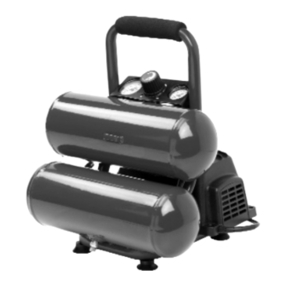
Campbell Hausfeld
Campbell Hausfeld FP209501 Operating instructions and parts manual
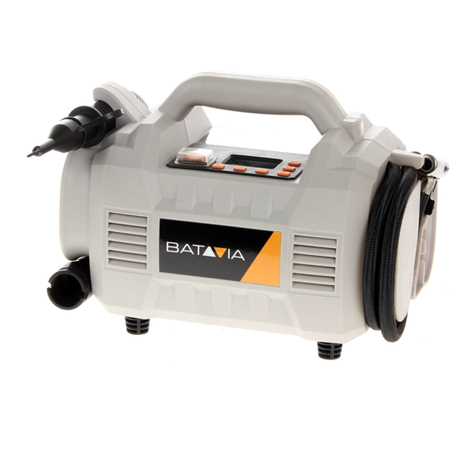
Batavia
Batavia MAXXPACK BT-CAC001 operating instructions

Comprag
Comprag D7510 manual
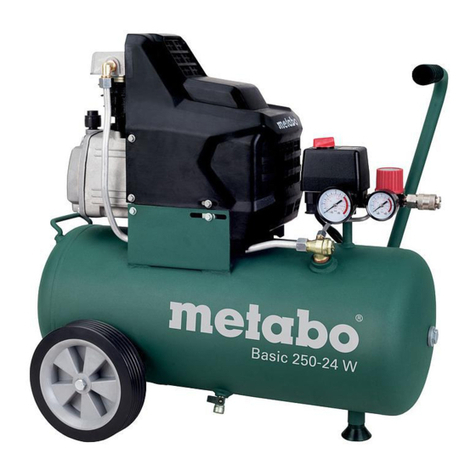
Metabo
Metabo Basic 250-24 W OF Original operating instructions
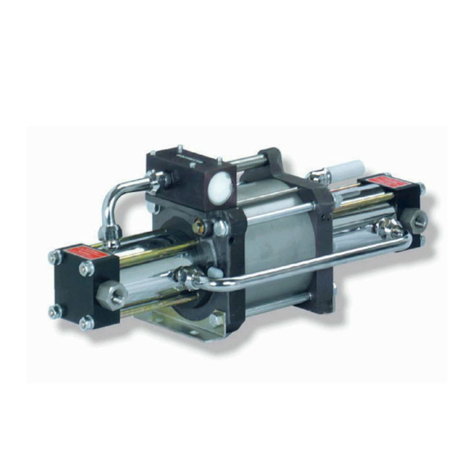
MAXIMATOR
MAXIMATOR DLE 5 Operating, maintenance and repair instructions
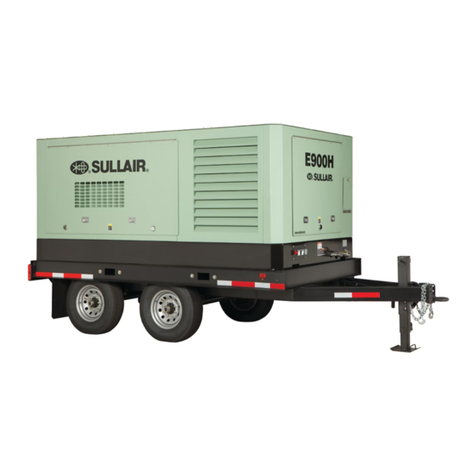
Sullair
Sullair E900H user manual
